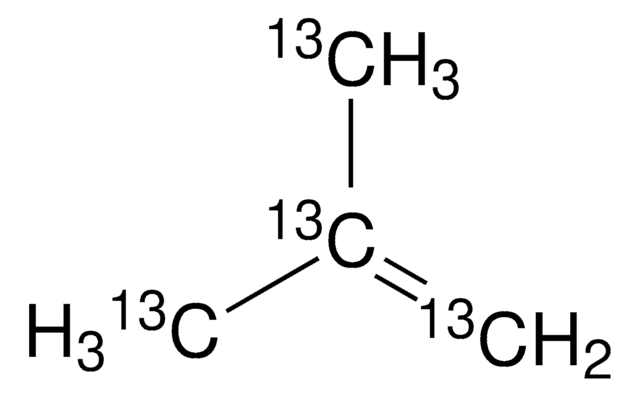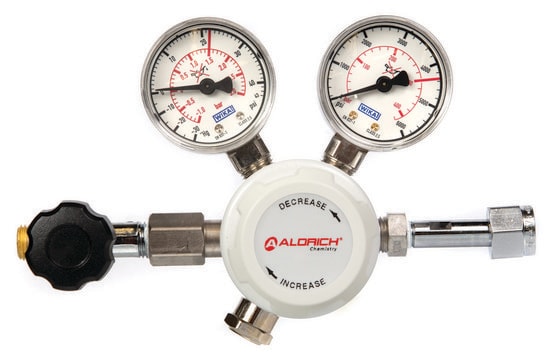58552
2-Methylpropene
purum, ≥99.5%
Synonym(s):
Isobutylene
Sign Into View Organizational & Contract Pricing
All Photos(1)
About This Item
Linear Formula:
(CH3)2C=CH2
CAS Number:
Molecular Weight:
56.11
Beilstein:
773645
EC Number:
MDL number:
UNSPSC Code:
12142100
PubChem Substance ID:
NACRES:
NA.22
Recommended Products
vapor density
2 (vs air)
Quality Level
vapor pressure
3278 mmHg ( 37.7 °C)
grade
purum
Assay
≥99.5%
autoignition temp.
869 °F
bp
−6.9 °C (lit.)
SMILES string
CC(C)=C
InChI
1S/C4H8/c1-4(2)3/h1H2,2-3H3
InChI key
VQTUBCCKSQIDNK-UHFFFAOYSA-N
Looking for similar products? Visit Product Comparison Guide
Packaging
Cylinder with net ~3.6 kg
DIN 477 nr.1
Other Notes
Sales restrictions may apply
Recommended products
Z742161 DIN 1 Regulator OR 99112 DIN 1 Valve
Signal Word
Danger
Hazard Statements
Precautionary Statements
Hazard Classifications
Flam. Gas 1 - Press. Gas Liquefied gas
Storage Class Code
2A - Gases
WGK
nwg
Flash Point(F)
-112.0 °F - closed cup
Flash Point(C)
-80 °C - closed cup
Personal Protective Equipment
dust mask type N95 (US), Eyeshields, Gloves
Choose from one of the most recent versions:
Already Own This Product?
Find documentation for the products that you have recently purchased in the Document Library.
Bianca N M van Leeuwen et al.
Applied microbiology and biotechnology, 93(4), 1377-1387 (2012-01-12)
Isobutene (2-methylpropene) is one of those chemicals for which bio-based production might replace the petrochemical production in the future. Currently, more than 10 million metric tons of isobutene are produced on a yearly basis. Even though bio-based production might also
Nava Dayan et al.
Journal of cosmetic science, 60(1), 15-24 (2009-03-20)
Hydrogenated polyisobutene (HP) is used in topically applied cosmetic/personal care formulations as an emollient that leaves a pleasing skin feel when applied, and rubbed in after application. This effect, although distinguishable to the user, is difficult to define and quantify.
Cyril Vancura et al.
Analytical chemistry, 79(4), 1646-1654 (2007-02-15)
A novel resonant cantilever sensor system for liquid-phase applications is presented. The monolithic system consists of an array of four electromagnetically actuated cantilevers with transistor-based readout, an analog feedback circuit, and a digital interface. The biochemical sensor chip with a
Markus Burkhardt et al.
Langmuir : the ACS journal of surfaces and colloids, 24(5), 1769-1777 (2008-01-30)
We report on interpolyelectrolyte complexes (IPECs) formed by micelles of ionic amphiphilic diblock copolymers with polyisobutylene (PIB) and poly(sodium methacrylate) (PMANa) blocks interacting with quaternized poly(4-vinylpyridine) (P4VPQ). The interpolyelectrolyte complexation was followed by turbidimetry and small angle neutron scattering (SANS).
Nicolas Cottenye et al.
Chemical communications (Cambridge, England), 48(20), 2615-2617 (2012-02-02)
The polymer modification of short nucleotide sequences has been achieved for future use as self-assembled biologically active structures with sizes in the nanometre range. Co-assembly of the resulting DNA-based amphiphilic block copolymers with native proteins demonstrates the self-assembly of biological-like
Our team of scientists has experience in all areas of research including Life Science, Material Science, Chemical Synthesis, Chromatography, Analytical and many others.
Contact Technical Service










